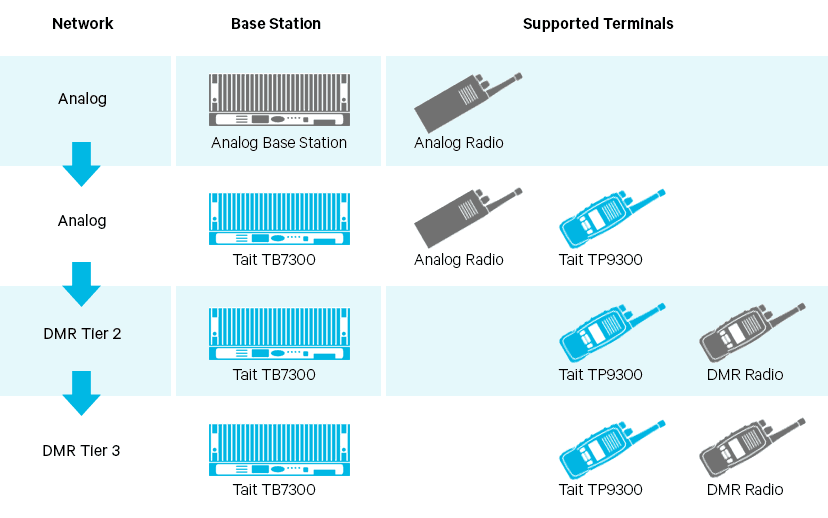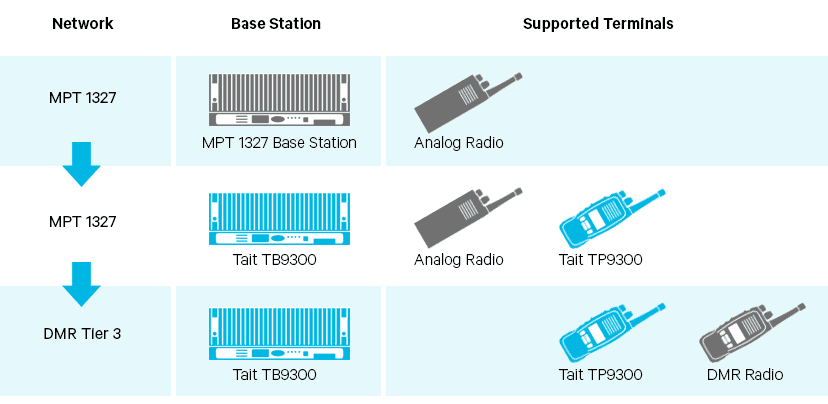This is the second in a series of articles we’ll be presenting on migrating from legacy radio networks to more modern technology, the advantages they can offer your organization and how Tait solutions can make it a simple process.
To view Part 1, go to Analog to P25 migration process.
Migrating from Analog to DMR
 Many organizations continue to use old analog or MPT radio networks simply because they’re familiar and trusted, despite the range of great features offered by modern digital radio. Fortunately, the path to upgrade from analog to DMR (digital mobile radio) is simple and can yield a number of great benefits for your business.
Many organizations continue to use old analog or MPT radio networks simply because they’re familiar and trusted, despite the range of great features offered by modern digital radio. Fortunately, the path to upgrade from analog to DMR (digital mobile radio) is simple and can yield a number of great benefits for your business.
Why upgrade to DMR?
Open Standards
DMR is an open digital mobile radio standard used by utilities, transport agencies, mining, oil and gas companies around the world. In most cases, products that meet the DMR standard will work on any DMR network, providing choice and competitive pricing for hardware.
Digital Audio Quality
Unlike analog radio, DMR uses a digital vocoder to create a clear voice signal, minimizing environmental noise and delivering an easily audible message. Where an analog signal would degrade as coverage decreases, digital radio maintains high quality to the edge of coverage area.
Data Applications that increase worker safety and efficiency
 DMR offers a data channel along with voice, which can be utilized in a variety of useful ways, from delivering GPS location data to SCADA and telemetry data. Services like Lone Worker and Man Down take advantage of this data channel for worker safety features.
DMR offers a data channel along with voice, which can be utilized in a variety of useful ways, from delivering GPS location data to SCADA and telemetry data. Services like Lone Worker and Man Down take advantage of this data channel for worker safety features.
Greater Channel Capacity
DMR uses two-slot TDMA technology to deliver two voice channels where an analog radio radio network could only support one. This allows for twice the communication channels on your existing frequency band.
Ease of Migration
DMR uses very similar transmission technology to analog radio, meaning the process of upgrading may be easier and less expensive than you think. Tait can offer a solution that makes the transition especially seamless.
The Path to Digital
The key to easy transition from analog radio to DMR is equipment that can be used between technologies, like the Tait TB9300, TB9400, TB7300 base station, the TP9500, TP9300, TP3, TP2 portable, and TM9300 mobile radios, which feature four different operating modes – conventional FM, MPT 1327, conventional DMR Tier 2 and trunked DMR Tier 3. Using devices like this allows you to upgrade from analog to DMR as your needs dictate.
Depending on your existing radio network, there are a several potential migration paths to DMR. If you are using a conventional analog system, you may upgrade to DMR Tier 2. However, if you are taking advantage of a trunked MPT 1327 you’ll likely upgrade to DMR Tier 3, as the standard supports trunked talkgroups.
Example 1: Analog to DMR

If you’re using an analog radio network and want to take advantage of the features of DMR, you’ll need to eventually upgrade both your base stations and your radios to DMR capable models. Fortunately, this process is made much easier by sourcing radios and base stations that can operate in both analog and DMR mode, like the Tait TP9300 radio and Tait TB7300 base station. These devices can be added to your network without disruption, continuing to run in analog mode until you’re ready to switch over to DMR.
If your organisation then grows to the point of needing a trunked radio network, you’ll already have all the infrastructure and hardware required to switch to DMR Tier 3.
The transition to DMR offers a drastic increase in the utility your radio network can offer. Now not only a means for voice communication, your network can utilize applications that instantly transmit data from users wherever they are, improving safety and operational efficiency.
Example 2: MPT 1327 to DMR

If you’re using a trunked MPT 1327 network and wish to upgrade to DMR, you’ll need to switch to DMR Tier 3 to maintain your trunked functionality. As part of this process, you will need to upgrade both your radios and base stations to DMR capable models. This process can be made easier by choosing the Tait TB9300 base station and Tait TP9300 radios, which can operate in either MPT 1327 or DMR mode, allowing you to continue to operate your MPT 1327 network without disruption while the migration takes place.
Once you have DMR capable radios and base stations installed, switching from MPT 1327 to DMR Tier 3 is just a matter of a software update at the base station. It’s as simple as that.
Start your Migration today
Tait makes the migration from analog to DMR radio networks simple, providing your company great tools to help get their jobs done safely and efficiently. Every organization has unique needs, and our goal at Tait is to listen to your situation and propose the easiest migration path for you. The flexibility of solutions like the 9300 series makes this possible.
If you’re interested in learning more about migrating your analog radio network to a modern digital network, get in touch with Tait Communications to discuss a long term solution that meets your organization’s needs.



